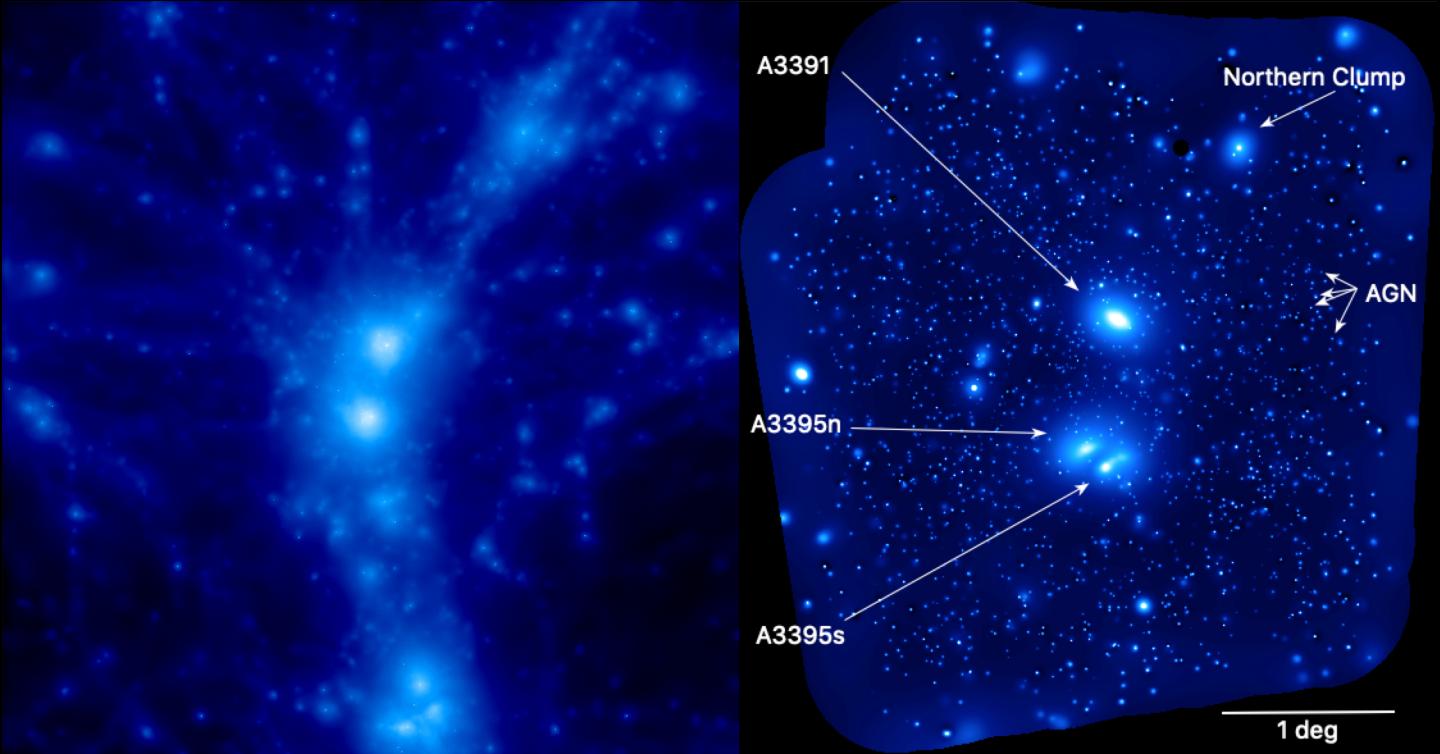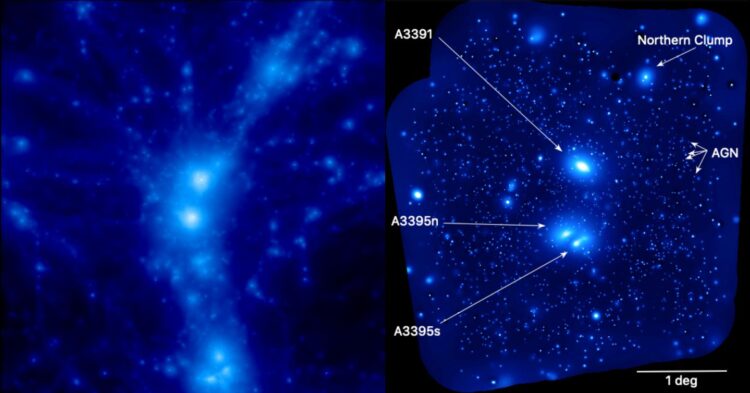Study confirms models on the evolution of our universe

Credit: Reiprich et al., Astronomy & Astrophysics
More than half of the matter in our universe has so far remained hidden from us. However, astrophysicists had a hunch where it might be: In so-called filaments, unfathomably large thread-like structures of hot gas that surround and connect galaxies and galaxy clusters. A team led by the University of Bonn (Germany) has now for the first time observed a gas filament with a length of 50 million light years. Its structure is strikingly similar to the predictions of computer simulations. The observation therefore also confirms our ideas about the origin and evolution of our universe. The results are published in the journal Astronomy & Astrophysics.
We owe our existence to a tiny aberration. Pretty much exactly 13.8 billion years ago, the Big Bang occurred. It is the beginning of space and time, but also of all matter that makes up our universe today. Although it was initially concentrated at one point, it expanded at breakneck speed – a gigantic gas cloud in which matter was almost uniformly distributed.
Almost, but not completely: In some parts the cloud was a bit denser than in others. And for this reason alone there are planets, stars and galaxies today. This is because the denser areas exerted slightly higher gravitational forces, which drew the gas from their surroundings towards them. More and more matter therefore concentrated at these regions over time. The space between them, however, became emptier and emptier. Over the course of a good 13 billion years, a kind of sponge structure developed: large “holes” without any matter, with areas in between where thousands of galaxies are gathered in a small space, so-called galaxy clusters.
Fine web of gas threads
If it really happened that way, the galaxies and clusters should still be connected by remnants of this gas, like the gossamer-thin threads of a spider web. “According to calculations, more than half of all baryonic matter in our universe is contained in these filaments – this is the form of matter of which stars and planets are composed, as are we ourselves,” explains Prof. Dr. Thomas Reiprich from the Argelander Institute for Astronomy at the University of Bonn. Yet it has so far escaped our gaze: Due to the enormous expansion of the filaments, the matter in them is extremely diluted: It contains just ten particles per cubic meter, which is much less than the best vacuum we can create on Earth.
However, with a new measuring instrument, the eROSITA space telescope, Reiprich and his colleagues were now able to make the gas fully visible for the first time. “eROSITA has very sensitive detectors for the type of X-ray radiation that emanates from the gas in filaments,” explains Reiprich. “It also has a large field of view – like a wide-angle lens, it captures a relatively large part of the sky in a single measurement, and at a very high resolution.” This allows detailed images of such huge objects as filaments to be taken in a comparatively short time.
Confirmation of the standard model
In their study, the researchers examined a celestial object called Abell 3391/95. This is a system of three galaxy clusters, which is about 700 million light years away from us. The eROSITA images show not only the clusters and numerous individual galaxies, but also the gas filaments connecting these structures. The entire filament is 50 million light years long. But it may be even more enormous: The scientists assume that the images only show a section.
“We compared our observations with the results of a simulation that reconstructs the evolution of the universe,” explains Reiprich. “The eROSITA images are strikingly similar to computer-generated graphics. This suggests that the widely accepted standard model for the evolution of the universe is correct.” Most importantly, the data show that the missing matter is probably actually hidden in the filaments.
###
Reiprich is also a member of the Transdisciplinary Research Area (TRA) “Building blocks of matter and fundamental interactions” at the University of Bonn. In six different TRAs, scientists from the most diverse faculties and disciplines come together to work collaboratively on future-relevant research topics of the University of Excellence.
Almost 50 scientists from institutions in Germany, the USA, Switzerland, Chile, Australia, Spain, South Africa, and Japan participated in the study.
Publication:
T.H. Reiprich among others: The Abell 3391/95 galaxy cluster system: A 15 Mpc intergalactic medium emission filament, a warm gas bridge, infalling matter clumps, and (re-) accelerated plasma discovered by combining eROSITA data with ASKAP/EMU and DECam data, Astronomy & Astrophysics, DOI: 10.1051/0004-6361/202039590
Media Contact
Prof. Thomas Reiprich (University of Bonn)
[email protected]
Original Source
https:/
Related Journal Article
http://dx.





